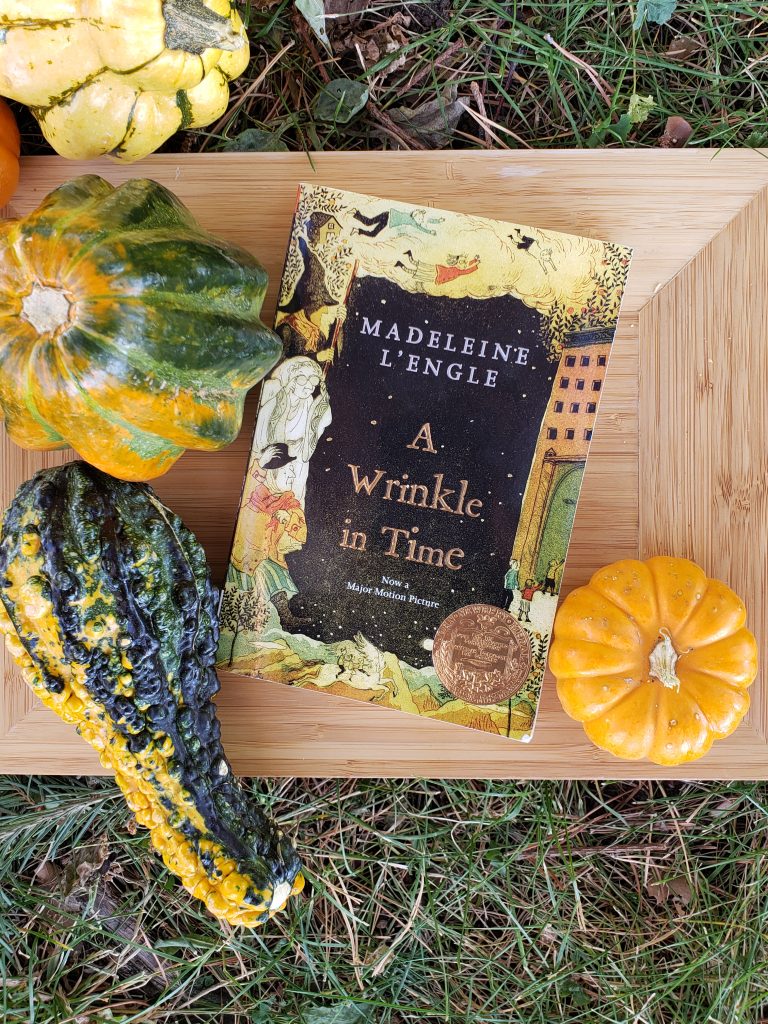Good books are even better when people discuss them. In fact, we label books “discussion starters” when they offer much food for thought.
A Wrinkle in Time is one such book. Unfortunately, kids often read this book at far too young an age and think they don’t like it. Even if your child reads at an “advanced reading level,” he or she is probably not going to “get” this book until around age 12 or even older. Don’t despair if you tried to read this book aloud to a 4th grader; just hand the book over as a book club pick once a few years have passed.
Note: We’ve covered Wrinkle before several times on Redeemed Reader, once for its 50th anniversary, once when looking at the graphic novel version, and once during our summer reading challenge. This post will only cover information pertinent to a book club setting. However, the summer reading challenge post, in particular, has some great additional questions! Do check it out.

A Wrinkle in Time: Book Club Edition
Background:
Take the time to look up some information on Madeleine L’Engle. The following is an excerpt from the official Madeleine L’Engle website, but do explore the website for more interesting information!
“If I’ve ever written a book that says what I believe about God and the universe, this is it,” Madeleine L’Engle confided to her private journal on June 2nd, 1960.
But A Wrinkle in Time would not be published for another two years. Editors didn’t think it would sell.
“I know [this] is a good book,” Madeleine told herself, shaking off the first few snubs. “…This is my psalm of praise to life, my stand for life against death.”
The novel was not easily classifiable, and therefore not easily marketable. Madeleine and the book she believed to be her masterpiece received some 25 to 40 rejections (she revised the number with each retelling). Finally, A Wrinkle in Time found a home at the literary house of Farrar, Straus & Giroux, who published it in 1962.
A Wrinkle in Time went on to win the prestigious 1963 Newbery medal and has sold over 16 million copies in more than 30 languages, and counting.
But the attention wasn’t always positive. Given the enormous popularity of the Narnia books, especially embraced by evangelicals, Madeleine was dismayed by the outcry over A Wrinkle in Time and its four sequels. The books were controversial for their use of religion—some thought there was too much, others not enough. Conservative evangelicals lobbied for its removal from school libraries, accusing her of promoting witchcraft and “New Age-ism.” Many Christian bookstores refused to sell A Wrinkle in Time. The book now holds the distinction of being one of the most frequently banned novels in American literature.
A Ring of Endless Light won a Newbery Honor in 1980. Swiftly Tilting Planet won a Newbery Honor in 1981.
Snacks:
Snacks are always welcome at a book club, especially if teens are present. Hot chocolate (“cocoa”) and sandwiches are a good choice for Wrinkle because the kids have these in the kitchen the first night when Mrs. Whatsit appears. You can try liverwurst, but tuna or jam are probably more kid-friendly!
Questions:
Don’t forget to check out the summer reading challenge questions from a few years ago!
Discuss “banned books.” Is banning books a good idea? When should we (if at all)? Should A Wrinkle in Time be banned? Why/why not?
Who is your favorite character? (most likely, teens will say Meg, Calvin, or Charles Wallace). Who is the MAIN character? Why do you think so? (most people will say Meg, but you can make an argument that Charles Wallace is a solid runner-up)
The genre of A Wrinkle in Time is “science fiction.” In other words, it is a fantasy story that feels like it could happen if only we could learn the science. Do you think we can ever tesser? Does L’Engle’s story feel realistic given the science of today? (hint: the Madeleine L’Engle website has some interesting teacher resources related to this!)
What do you think about L’Engle’s mix of science and faith? (or “spirituality”) L’Engle was a professing Christian. Do you see elements of Christianity in this story? Or is it too vague to be considered Christian?
A lot of people like to talk about “diversity” today. What are some of the ways the characters in this book are “diverse”? Does this make the story more effective or less? Or neutral? (hint: Charles Wallace is what we would call “neuro-diverse” in today’s parlance)
What other questions can you think of? (Ask your students!)
For more book club fun, check out the following posts:
Support our writers and help keep Redeemed Reader ad-free by joining the Redeemed Reader Fellowship.
Stay Up to Date!
Get the information you need to make wise choices about books for your children and teens.
Our weekly newsletter includes our latest reviews, related links from around the web, a featured book list, book trivia, and more. We never sell your information. You may unsubscribe at any time.
We'd love to hear from you!
Our comments are now limited to our members (both Silver and Golden Key). Members, you just need to log in with your normal log-in credentials!
Not a member yet? You can join the Silver Key ($2.99/month) for a free 2-week trial. Cancel at any time. Find out more about membership here.

